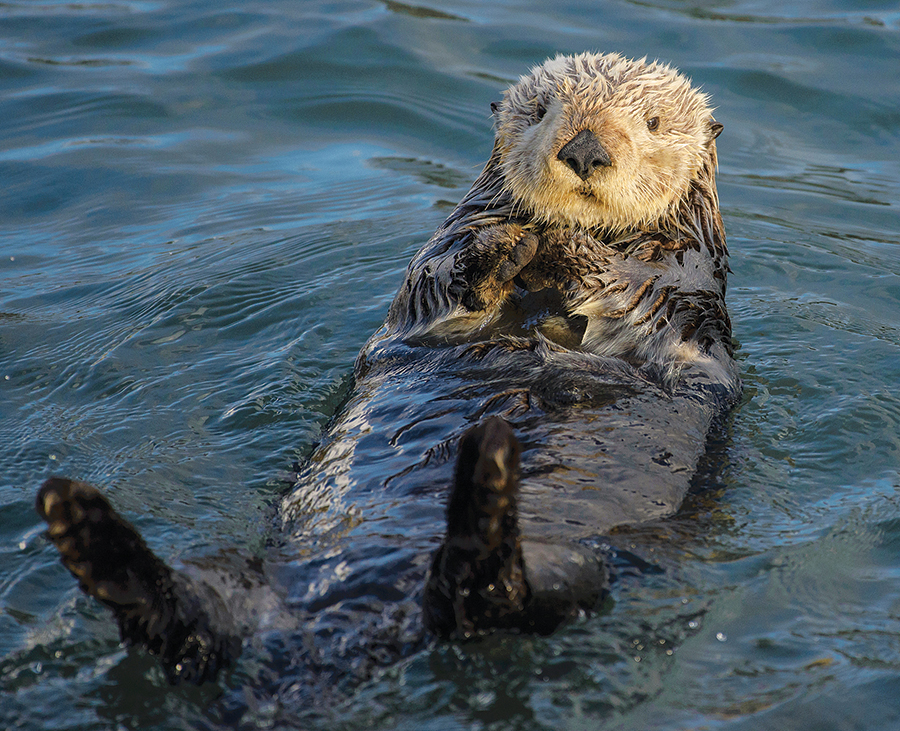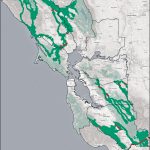
Researchers are weighing the idea of reintroducing sea otters into the San Francisco Bay estuary. Photo by Marshal Hedin.
When most people think of sea otters, they picture these charismatic creatures wrapped in kelp as they float on their backs in the ocean. But this iconic image is only part of the story. Sea otters also once abounded in the San Francisco Bay and other coastal estuaries. Now, a team of sea otter experts is raising the idea of bringing sea otters back to our bay.
“We’re moving the conservation needle forward,” said Brent Hughes, a Sonoma State University ecologist and lead author on a 2019 PeerJ paper that makes the case for reintroducing California sea otters to estuaries. These sheltered habitats form where freshwater from rivers mixes with salty water from the sea, and are bursting with life.
Prized for their luxuriant pelts, sea otters were hunted to the brink of extinction in California in the 1800s. A handful survived near Bixby Creek in Monterey County and today their descendants live as far north as Pigeon Point near Pescadero and as far south as Point Conception near Santa Barbara. After years of growth, however, the population of this endangered species is now stuck at about 3,000. Biologists believe sea otters have reached their limit along the Central Coast.
“For sea otters to have a future, they need to be able to expand their range,” said Lilian Carswell, the lead on sea otter recovery in California for the US Fish and Wildlife Service.
They’re not likely to do that on their own. The otters’ current range is bounded by waters frequented by great white sharks. These predators don’t eat sea otters but they do bite — and kill — them. And constantly being picked off at both ends of their range keeps the otters from spreading further. “They’re really trapped in Central California,” Carswell said.
The idea of sea otters in estuaries is not new. Rather, it’s been recently rediscovered. “The information is old,” Hughes explained. “Some has been forgotten and some was not well known.” Sea otters flourished in the San Francisco Bay two centuries ago, according to Adele Ogden’s 1941 book The California Sea Otter Trade. An abundance of sea otters swam in the waters here and hauled up on the shores, Ogden wrote, often congregating near the mouths of the many creeks that flowed into the bay.
Just as estuaries can be good places for sea otters to live, in turn the otters can boost the health of estuaries. Hughes documented this first-hand while studying the ecology of Elkhorn Slough, a small estuary on Monterey Bay. A few sea otters had settled the slough decades ago, and Hughes’ study overlapped with a Monterey Bay Aquarium initiative to bolster this small population.
The aquarium rescues orphaned sea otters, first fostering the pups with adults that serve as surrogate mothers and then returning the youngsters to the wild. Between 2002 and 2016, the aquarium released 37 rescued otters in Elkhorn Slough. The population shot up from about 40 to more than 150, with the rescued otters and their pups accounting for much of the increase. Today the slough’s population is self-sustaining. And Hughes discovered that as sea otters rebounded in Elkhorn Slough, the ecosystem there rebounded too.
Sea otters are already famous for benefitting the kelp forests that teem with life in the ocean. It goes like this. Sea otters are voracious, consuming about one quarter of their body weight daily. And they love sea urchins, which eat kelp. By chowing down on these invertebrates, sea otters keep them from denuding kelp forests.
Similarly, the otters play much the same role in estuaries, except here they benefit the seagrass beds where baby fish hide and older ones forage. Once again it comes down to the otters’ tremendous appetites, this time for crabs. “They love crabs — one sea otter can eat 8,000 a year,” Hughes said. Crabs don’t eat seagrass, but they do eat the smaller invertebrates that graze algae on seagrass. Those invertebrates are “like little lawnmowers,” Hughes explained. “They keep algae from overgrowing and killing seagrass.” By keeping crabs in check, sea otters allowed algae grazers — and so the sea grass beds in Elkhorn Slough — to bounce back.
“It’s a game-changer for how we look at sea otters,” Hughes said. “Managers used to have very limited options for expanding the population and now they have many — there are lots of estuaries along the California coast.”
Michelle Staedler, who manages the Monterey Bay Aquarium’s sea otter program, is enthusiastic about exploring these options. “The aquarium has already been thinking about this,” she said, adding that likely possibilities include Drake’s Estero, an estuary in Point Reyes National Seashore, and the San Francisco Bay, which is California’s biggest estuary by far.
The San Francisco Bay has such a wealth of invertebrates, from crabs to clams and mussels, that Hughes and his team estimate it could support about 6,600 sea otters — more than double the central coast population. The team also estimates that it would take about 20 sea otters to jumpstart a population in the bay. Staedler thinks that’s doable. While the Monterey Bay Aquarium only has the capacity to rescue and raise a few orphaned sea otter pups each year, she says other institutions are interested in joining the effort.
If sea otters did return to the bay, they would share it with the river otters that have recently returned on their own. Telling the two kinds of otters apart is pretty simple. Sea otters are about twice the weight of their riverine cousins, making them much bigger and bulkier. In addition, sea otters float on their backs and river otters don’t, and sea otters are clumsy on land while river otters are agile.
But not every estuary is right for sea otters. Hughes rattles off a list of potential threats to otters in the San Francisco Bay, including oil spills, being hit by ships and ferries, and eating shellfish contaminated with pollutants like heavy metals and methylmercury.
Likewise, while sea otters did wonders for Elkhorn Slough, they may not be right for every estuary. “They’re super cool and anything that can make an ecosystem more like what it was before development is neat,” said Dave Halsing, who manages the South Bay Salt Pond Restoration effort to reestablish more than 15,000 acres of tidal wetlands. But he also cautions that the San Francisco Bay has changed a lot since sea otters lived in there. “They’re essentially an introduced species — who knows what the impact would be?”
Mike Conroy, who directs the Pacific Coast Federation of Fishermen’s Associations, isn’t concerned that sea otters would affect his members. There are essentially no commercial fisheries left in the San Francisco Bay. But, like Halsing, he wonders about their impact. “They’ve been absent for a long time,” Conroy said. “Would they throw off the balance in the bay?”
This is the kind of conversation that Hughes and his team hope to spark within communities near coastal estuaries. Ultimately, whether or not to welcome sea otters back to the San Francisco Bay is something we will have to decide for ourselves. “Without discussion, nothing can happen,” Hughes said. “We have all of this new information. What are we going to do with it?”
Robin Meadows has spotted sea otters bobbing in waves along the Central Coast and floating in the calm waters of Elkhorn Slough. She first wrote about them in the 1980s, when the US Fish and Wildlife Service proposed establishing a sea otter population in the Channel Islands. Her interest in them is a family affair: her mother, Katherine Ralls, is a retired Smithsonian conservation biologist who studied sea otters and other endangered species.

